When most people think of Brazil, the first thing that comes to mind is their culture. Brazil is one of the largest countries in the world with various cultural influences, so it comes as no surprise that this is reflected in every famous dish in Brazil.
As one of the most biodiverse places on Earth, every famous dish is afforded exotic spices, and there is no shortage of meat as you will soon discover. Brazilians not only love their spices and meat, but they also have a deep love for their tropical fruits and vegetables.
If you’re planning a trip to this country on the South American continent, you must give at least one famous dish from each category a try.
What is Brazilian Cuisine?
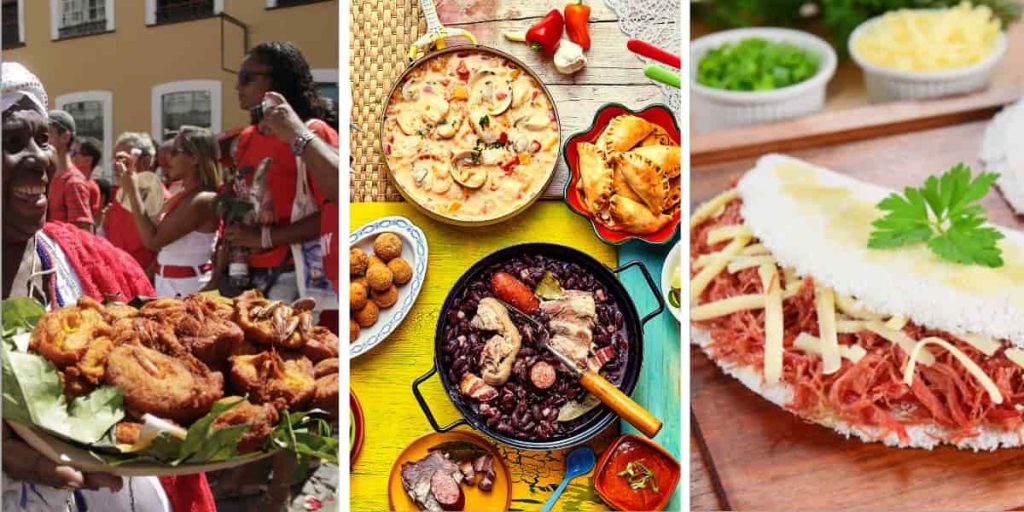
Brazil is the fifth-largest country in the world and the sixth-most populous. For this reason, there’s no definite or singular Brazilian cuisine.
Brazilian cuisine varies by region and is a mix of indigenous, colonial and immigrant influences including Amerindian (native), African, European and Asian.
The indigenous people of Brazil had a diet that consisted primarily of cassava, cashews, mangos, papaya, pineapples, root vegetables, passion fruit, açaí and guaraná. Colonization and immigration from European nations- primarily Portugal, the Netherlands, Spain, Germany, Poland, Ukraine and Italy- introduced dairy, leafy greens, wheat and wine.
African slaves and Asian indentured laborers introduced various culinary practices to Brazil, and bordering states such as Uruguay and Argentina melded some of their gaúcho (cowboys of South America) practices with Brazil. Coastal regions display the bounties of the Brazilian waters in their many seafood dishes.
Northern Brazil’s cuisine is heavily influenced by indigenous practices as they are a majority in that part of the country. There, a famous dish in Brazil made of duck, called Pato no tucupi, is king. To the North- East, descendants of African slaves live in harmony and blend with the indigenous population, whose influence is evident in foods such as acarajé, bobó de camarão and vatapá, with heavy use of ingredients such as palm oil, plantains and yams.
Central Brazil is dominated by indigenous and mixed peoples and is the backbone of Brazil’s agricultural sector. Meat is the base for many meals in this region, as are grains.
Heavy German migration and a long history of livestock rearing in southern Brazil means churrasco, or barbeque, is very common. Italian, Spanish and Portuguese influences in the South-East introduced pastas, olive oil and traditional cheeses.
The beauty of traveling within Brazil is that each region has a unique palate. You will discover this as you try each famous dish in Brazil.
Famous Appetizers in Brazil
1. Vatapá (Yellow Seafood Puree)
Vatapá is one of the most famous dishes in Brazil. It sometimes functions as a topping, but it may also be enjoyed on its own as an appetizer.
Vatapá is a bright yellow puree that includes bread, prawns, fish, coconut milk, palm oil, cashews and herbs.
Some claim the dish was invented in north-eastern Brazil, but there’s evidence that says it was brought there from West Africa.
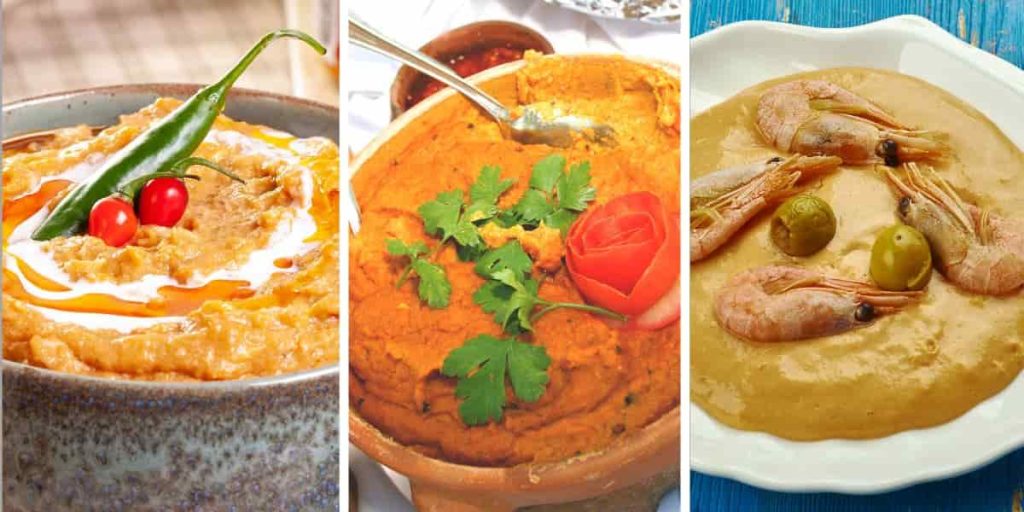
2. Arrumadinho (Sliced Sun-dried Beef with Peas and Toasted Cassava)
Arrumadinha is an attractive appetizer and a famous dish in Brazil. The name means “Neatly organized” when translated from Portuguese, and that it is.
It is traditionally made using only four ingredients: sliced sun-dried beef, diced mixed vegetable vinaigrette, black-eyed peas and farofa (toasted cassava/corn mix). Guests then mix the ingredients and eat them together.
Arrumadinho goes well with a cold beer and is the perfect group appetizer.
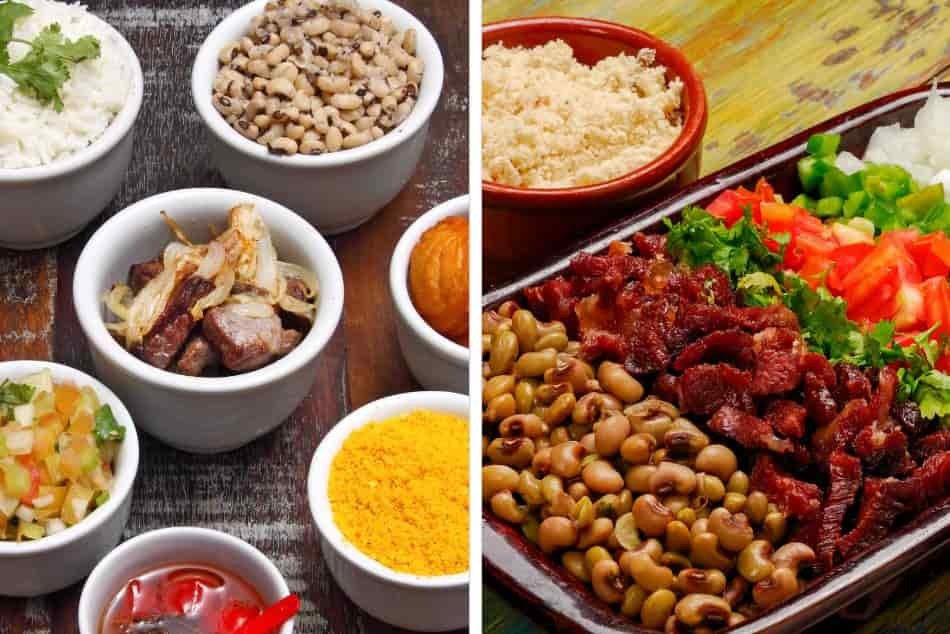
3. Casquinhas de Siri (Crab Shells)
If you’re looking for a sea-food-based appetizer, then Casquinhas de Siri is a famous dish in Brazil that will feed your marine appetite.
Casquinhas de Siri is made primarily of crab meat, which is sauteed with coconut milk, crustless bread, tomatoes, onions, bell peppers, cilantro, parsley and cassava flour. The mixture is then scooped into crab shells and baked.
Served piping hot, casquinhas de siri may rest over shredded cabbage, or can be eaten with hot sauce and lime wedges.
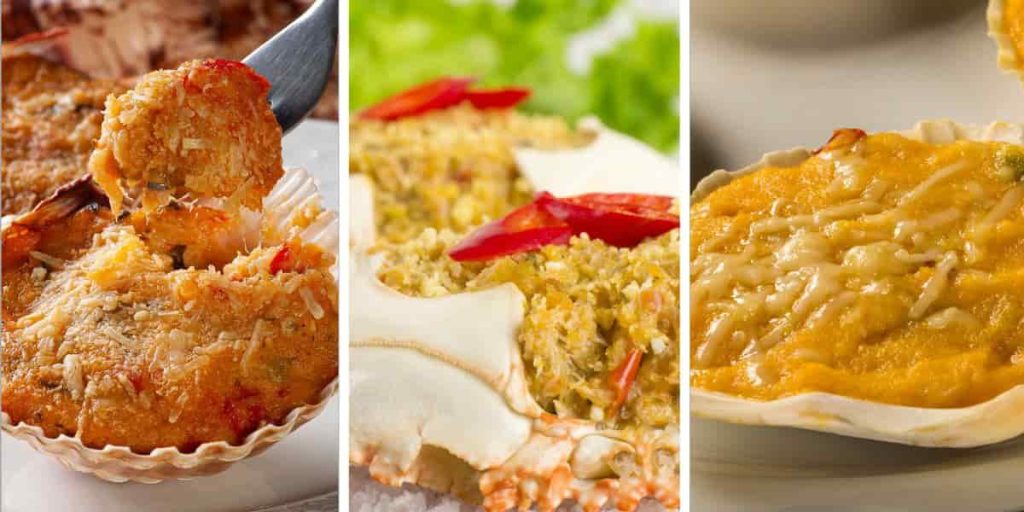
4. Tapioca (Brazilian crepes)
Tapioca is a starch derived from cassava, and when in the hands of Brazilians becomes an amazing appetizer.
On its own, tapioca is fairly tasteless, but it comes to life with fillings ranging from meat to jams. Tapioca can also be made into porridge, pancakes (beinju), wraps, soups or even stews.
It is one of the most diverse ingredients in Brazil, and you will probably find different versions of it suitable for different meal- times throughout the day.
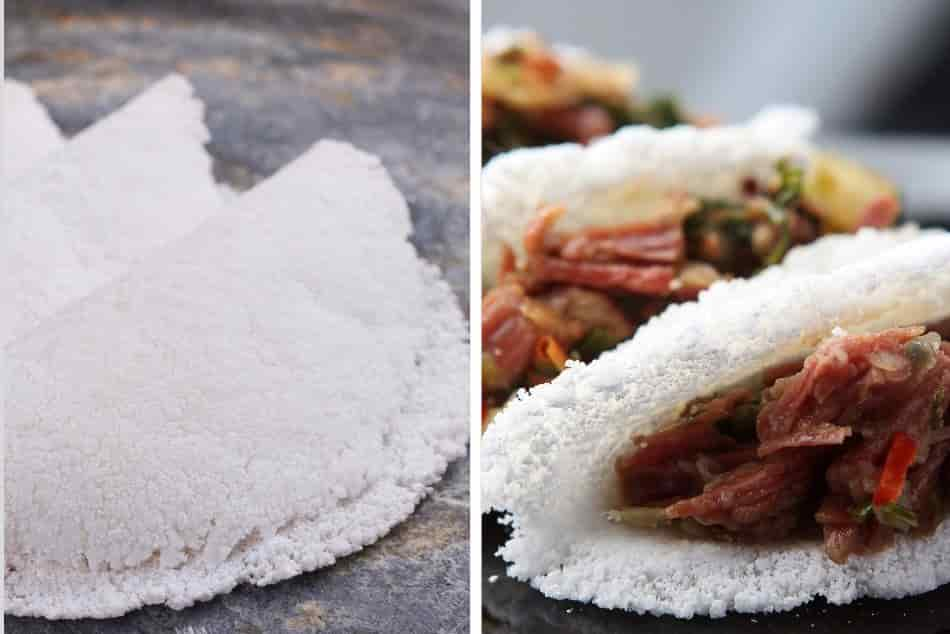
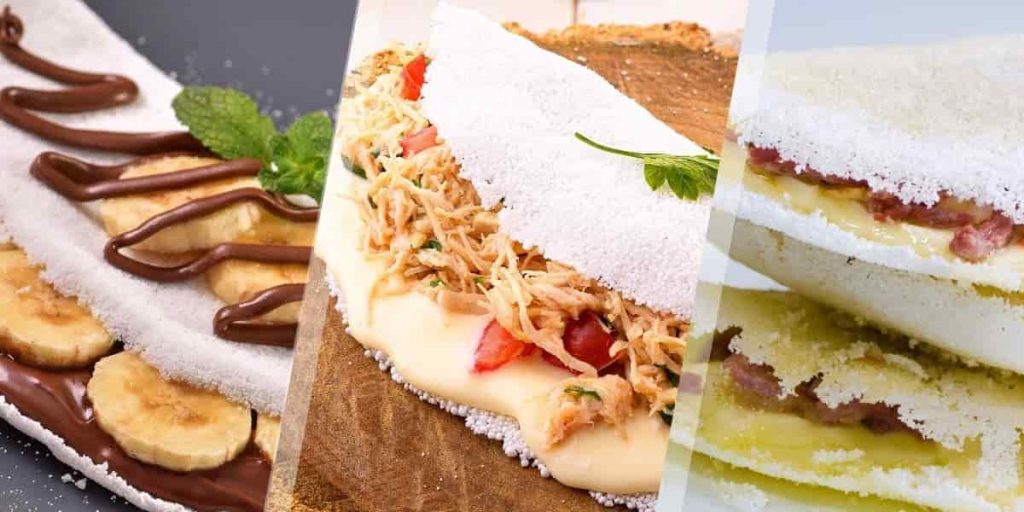
Popular Main Courses to Try in Brazil
5. Feijoada (Smoked Pork and Black Beans)
Feijoada is one famous dish in Brazil you must try while there. It is the national dish of the country and represents the melting pot that is the nation of Brazil. Feijoada arrived in Brazil from Portugal and underwent a drastic transformation thanks to local ingredients and the creativity of African slaves forced to eat undesirable cuts of pork.
It was traditionally prepared on Wednesdays and Saturdays as a “Big lunch” and is made from smoked pork, combined with seasoned black beans, garlic, onions, tomatoes, and other herbs and seasonings.
Preparing feijoada is a painstaking 24-hour process that is well worth the effort. It is enjoyed with orange slices, kale, rice and cachaça (Brazilian liquor).
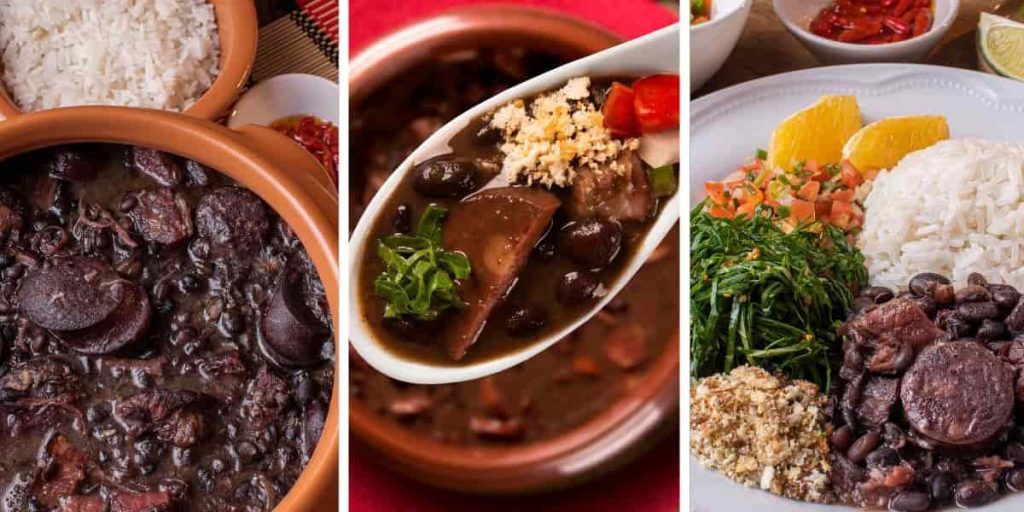
6. Picanha (Sirloin Cap Steak)
In Brazil, steakhouses have been referred to as “Churrascarias” since the days of guachos or cowboys in South America. Here, prized pieces of beef such as picanha are prepared as a famous dish in Brazil.
In the United States, picanha is called the sirloin cap and is prepared using its own fat. Traditionally, it is served rare and seasoned with only salt to allow the flavor of the meat to shine.
Picanha is one of the best cuts to order at any restaurant or steakhouse in Brazil, but the best time to have it is at an outdoor barbecue with a cold beer!
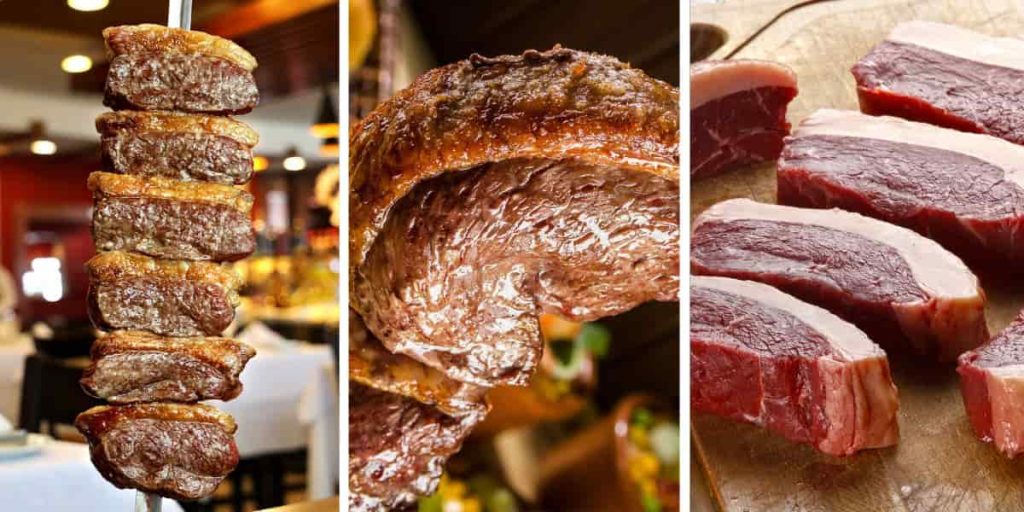
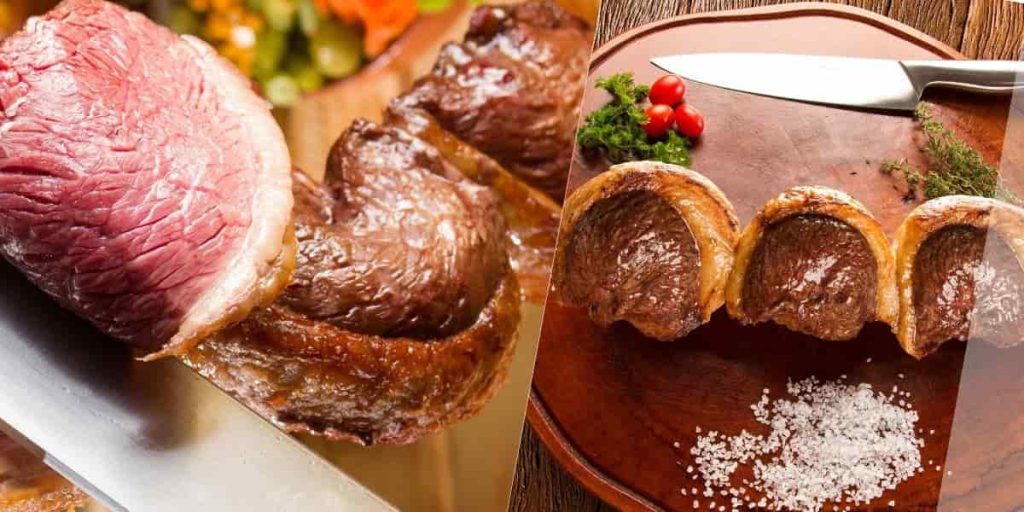
7. Baião de dois (Rice with Black-eyed Peas)
Baião de dois is a famous dish in Brazil named for its two star ingredients: rice and black-eyed peas, but not in the way that you may think.
In Brazil, baião is a music style and dance predominant in the North- East. Here, a perfectly paired couple dances together, just like the rice and black-eyed peas are prepared in unison.
Baião de dois may also feature cuts of beef, bacon, onions, garlic and curd cheese, but it was originally a mixture of scraps that locals couldn’t afford to throw away when times were tough.
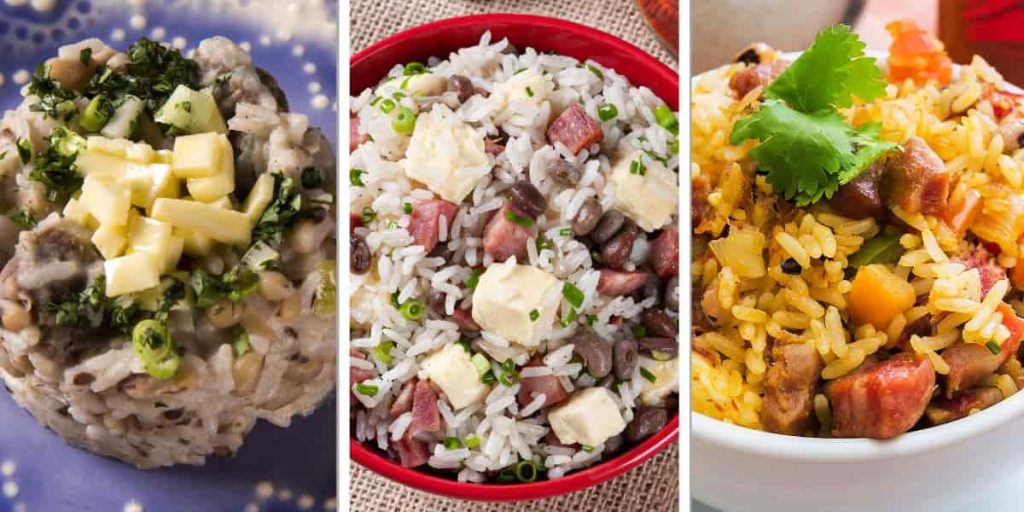
8. Pato no Tucupi (Roasted Duck in Tucupi Sauce)
Another famous dish in Brazil that originates in the north-eastern part of the country is pato no tucupi. Pato translates to “Duck” while the rest of the name means “in tucupi sauce”.
The dish is made by boiling the duck in tucupi sauce, an otherwise poisonous extract from the wild manioc root. The sauce is sometimes boiled for up to three to five days before serving to remove its toxicities. The result is an acidic, citrusy sauce that stews roasted duck, tomatoes, onions and Amazonian basil.
This famous dish in Brazil is then served over white rice and enjoyed during Círio de Nazaré, a local festival celebrating the Lazy of Nazareth.
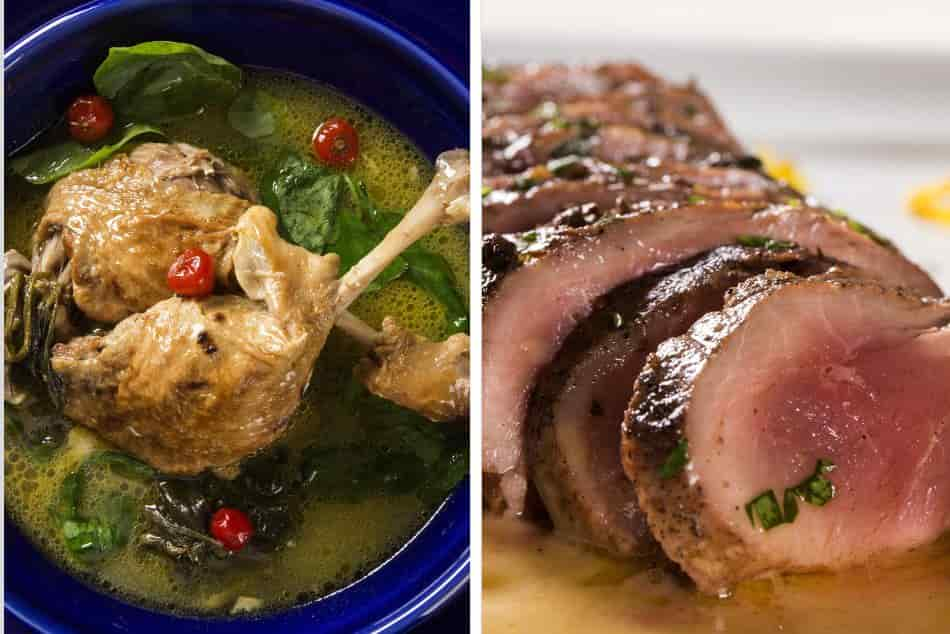
9. Escondidinho de carne (Hidden Meat / Shepherd’s Pie)
Escondidinho de carne is Brazil’s take on casserole or shepherd’s pie. Its main ingredients are crushed manioc and a combination of dried and salted meat.
Today, escondidinho de carne is usually made using beef, shrimp, chicken, fish or pork, and sometimes combinations of various meats sauteed in tomatoes, onions, garlic and spices.
Crushed manioc may be substituted for mashed potatoes, which are then topped with grated cheese. This famous dish in Brazil is served golden brown with a refreshing drink.


10. Feijão Tropeiro (Tropeiro Beans)
Feijão tropeiro is the star of Brazil’s South-East. It has a history rooted in necessity.
Before the invention of cars, trucks and trains, trade was conducted by the troops of cattle, or tropeiro, over long distances. This meant that they would need food that was filling and would not spoil easily for their travels. This food became what we know as feijão tropeiro. It includes salted or dried meat, manioc flour, beans and collard greens, all fried together.
Feijão tropeiro may be enjoyed on its own or with carne de sol, which are hunks of salted, sun-dried beef. There are many versions of feijão tropeiro in Brazil, so don’t be afraid to try them all!
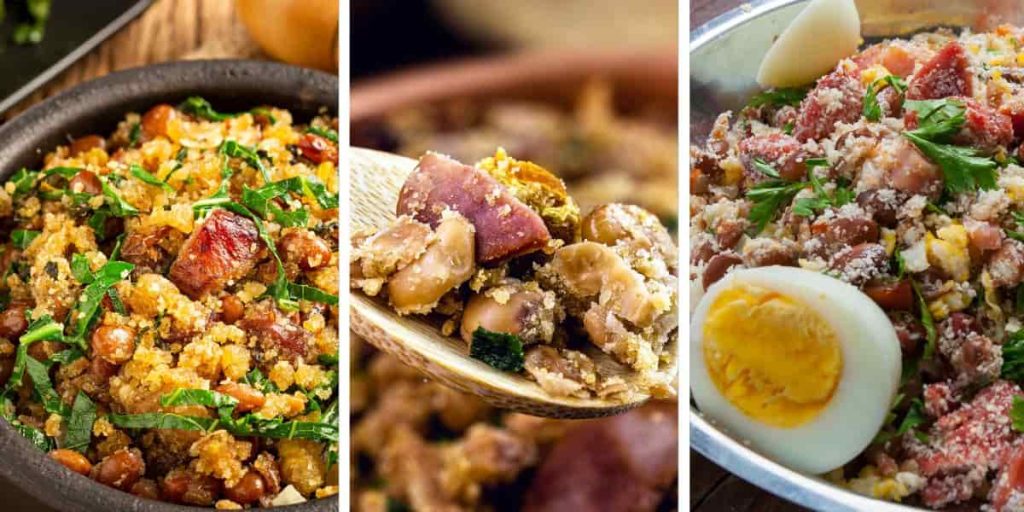
Popular Brazilian Desserts
11. Brigadeiro (Brazilian Chocolate Truffle)
If you pick a random Brazilian off the street and ask their opinion of the best Brazilian dessert, brigadeiro is a name you are likely to hear. Brigadeiros are enjoyed daily and are a staple at birthday parties and other celebrations.
Brigadeiro is the Brazilian version of a chocolate truffle, introduced in the 1940s. It consists of simple ingredients, namely condensed milk, butter and cocoa powder, which are rolled into balls and topped with chocolate sprinkles.
Other versions of brigadeiro exist, such as strawberry, but most Brazilians prefer their brigadeiro made of chocolate. You can look forward to this delicacy melting in your mouth, as you lose count of how many you’ve already eaten!
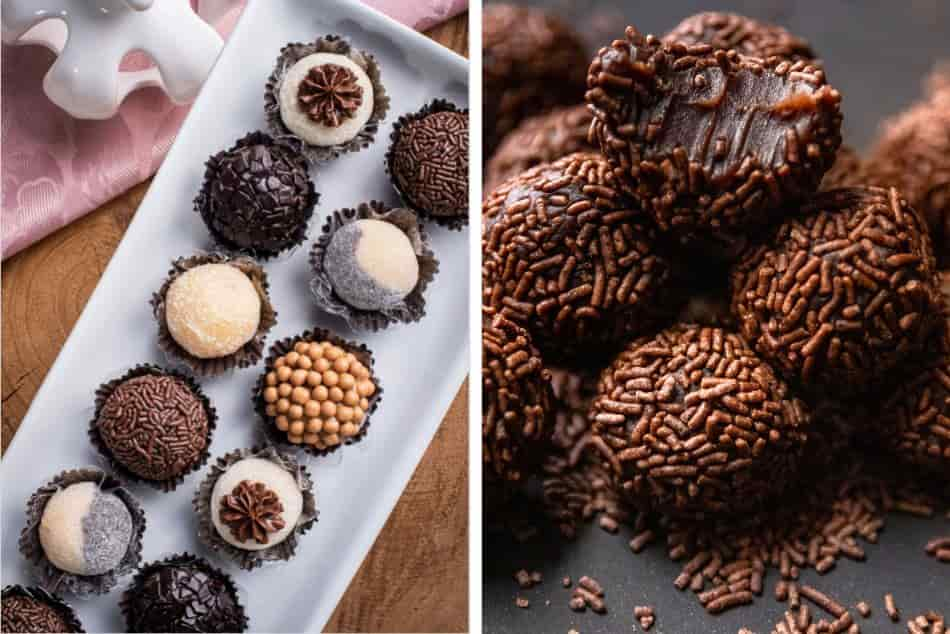
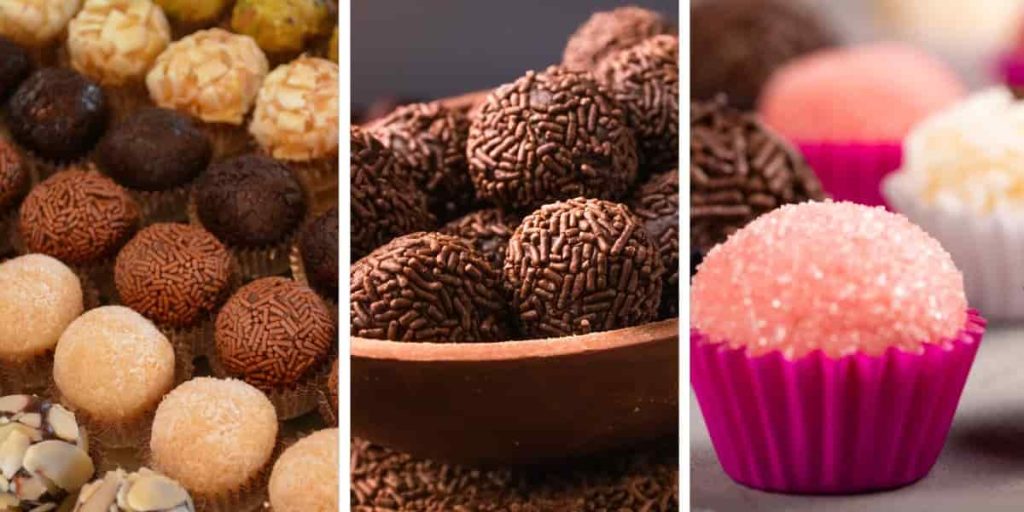
12. Quindim (Brazilian Flan)
Quindim was brought to Brazil from Portugal in the 16th century and is said to be the cousin of flan. It is a bright yellow custard traditionally made from egg yolk, sugar and ground coconut, and sometimes includes butter.
Quindim is about the size of a small cupcake. It is a household favorite in Brazil, especially in the North-East where Afro-Brazilians have perfected family recipes. The name itself was influenced by the African word “Kintiti”, meaning “Delicacy”.
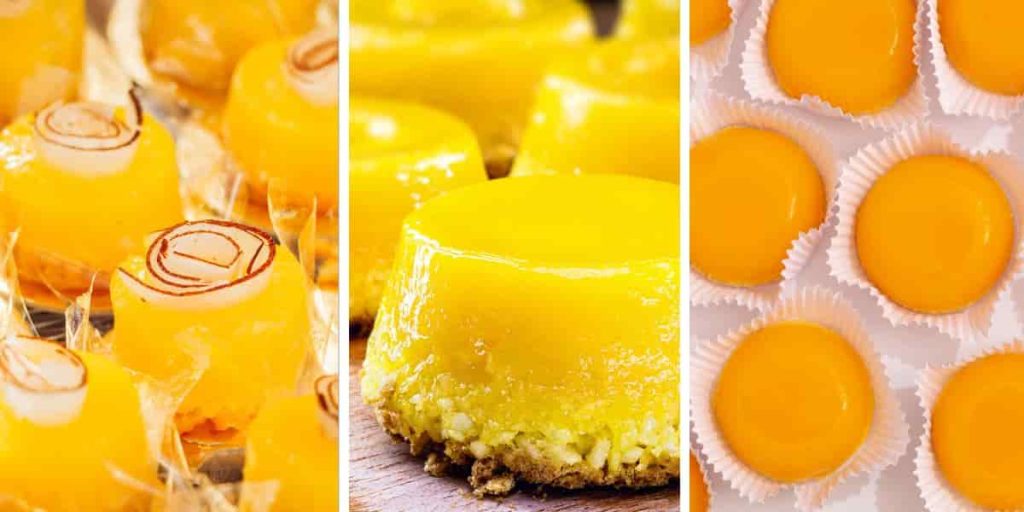
13. Açai
Açai bowls have become increasingly popular over the last couple of years due to social media trends, but did you know that this dessert was created in Brazil?
The indigenous people of Brazil are who we have to thank for their use of the superfood in their cooking, pairing it with, surprisingly, fish. This may seem strange, since the açai you are used to comes in fruit salads, yoghurt, juices and smoothies today.
When in Brazil, you are likely to see it served in a variety of ways. Just note that the fruit is bitter by itself, so you might want to add a bit of sugar to any desserts!
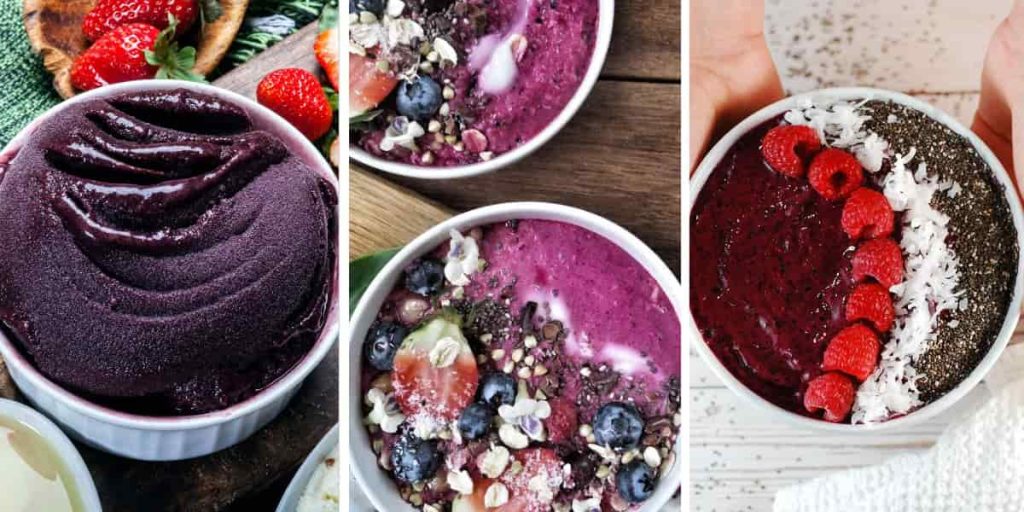
14. Passion fruit mousse
Mousse de maracujá, or passion fruit mousse, is a refreshing Brazilian dessert made with fresh passion fruit, sweetened milk and evaporated milk. It can be a homemade treat, or a staple at Brazilian restaurants and dinner parties.
Passion fruit mousse marries the sweetness of the milk with the tartness of the passion fruit to make what some call the national dessert of Brazil.
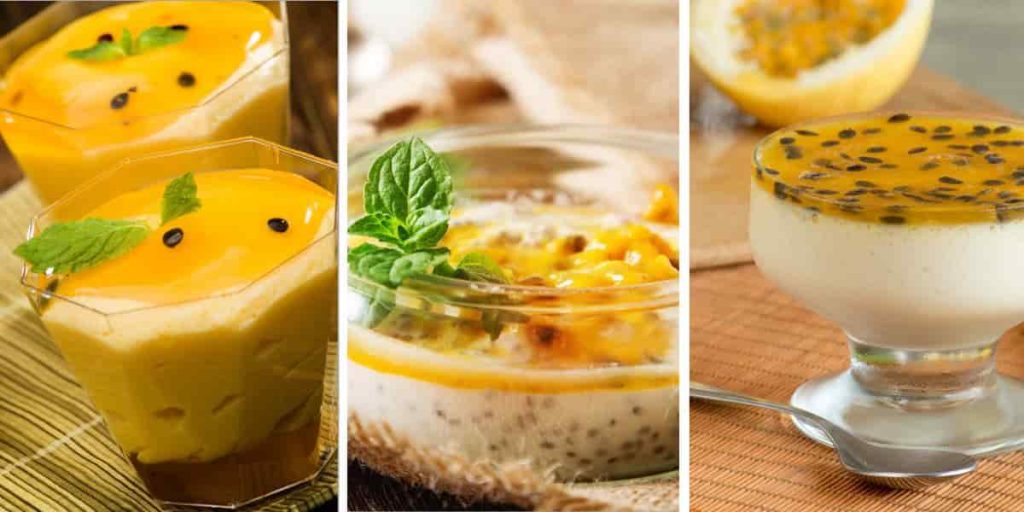
Famous Snacks / Pastry to Try When You Are in Brazil
15. Coxinha (Little Thigh)
If you step foot in any Brazilian bar, the first thing you will probably see on the menu is something called coxinha. It’s also sold widely across Brazil as street food. Coxinha translates to “Little thigh” because the original version was made using chicken thighs and was in that shape.
It is said that this food was created for Princess Isabel’s son, since he only ate chicken thighs. Whatever the case is, the modern version features processed meat coated with flour batter, and it is sometimes stuffed with cheese.
Other versions include different meats in the stuffing, but there are also vegetarian options with lentils and vegetables.
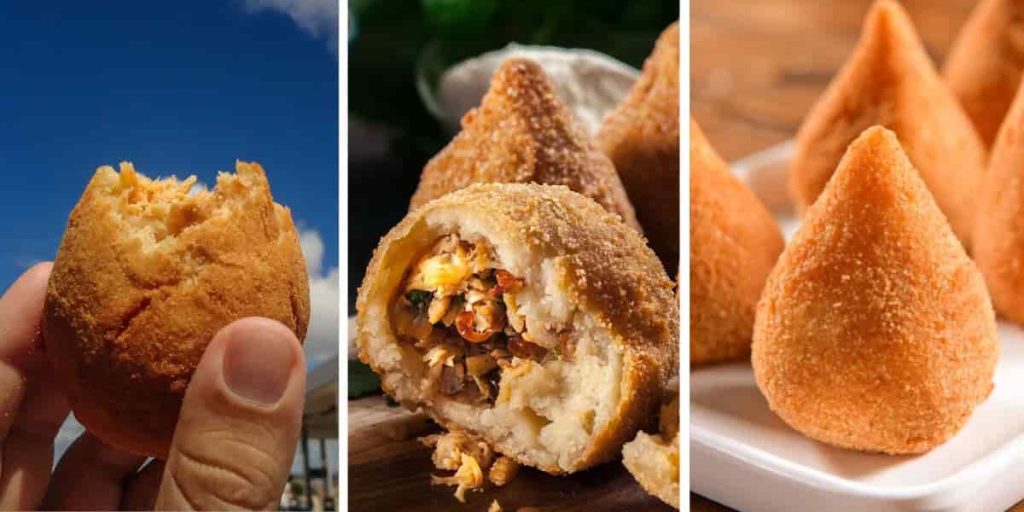
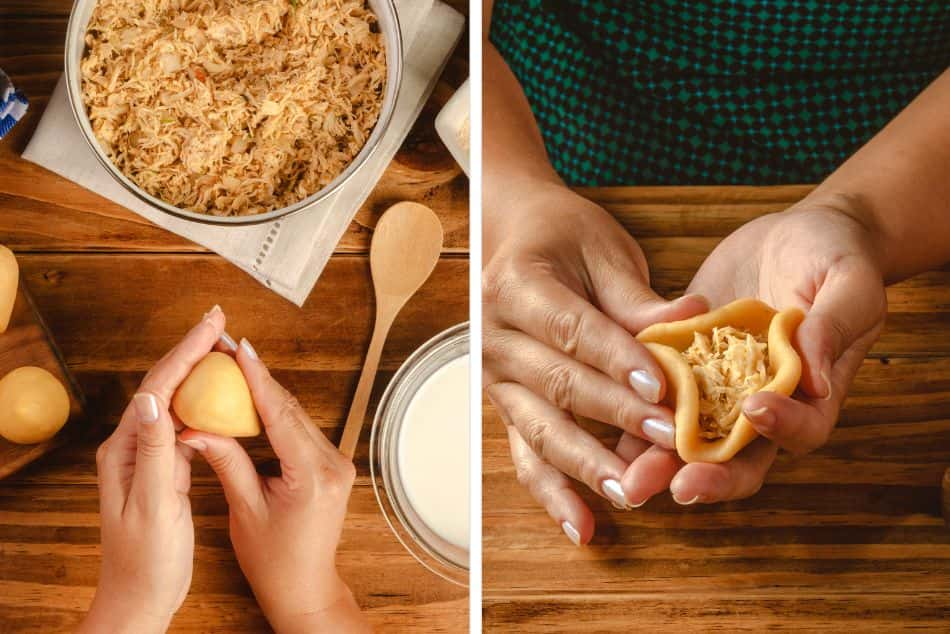
16. Pão de queijo (Cheese Bread)
Pão de queijo is similar to coxinha, in that it is a deep-fried ball, but that’s where the similarities end. The name pão de queijo translates to “Cheese bread” in English, and that’s exactly what it is.
Pão de queijo was introduced to Brazil by African slaves who were too poor to afford meat or cheese. Cassava was made into a white powder, which was then rolled into balls and baked. When slavery ended and the ex-slaves had more access to certain foods, cheese was introduced. This happened at the end of the 19th century in the dairy capital of Brazil, Minas Gerais. Since then, the mini cheese bread has become one of Brazil’s most beloved snacks.
Another great thing about pão de queijo is that it is completely gluten-free since the dough is not made from wheat!
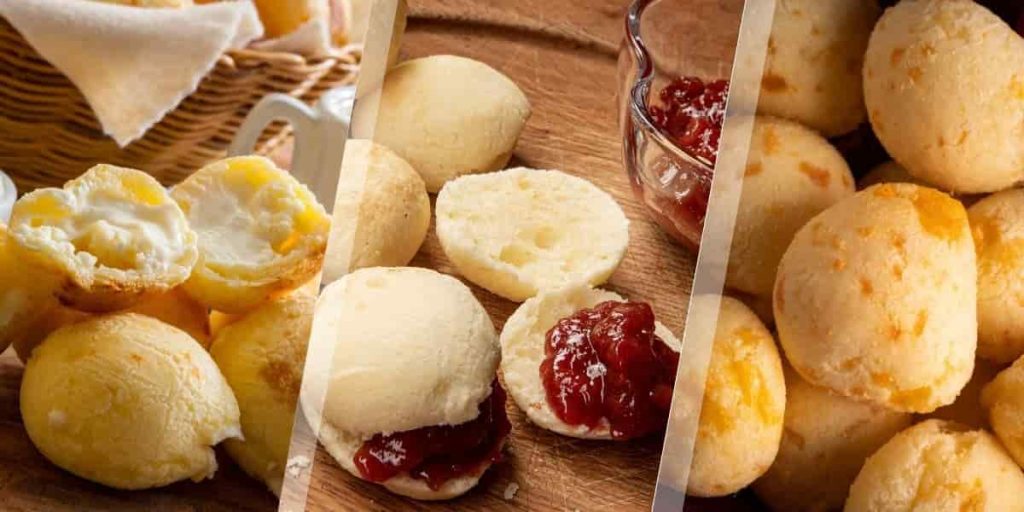
17. Pastél (Brazilian Spring Roll)
Pastél, or “Pastry” in English, is arguably one of Brazil’s most beloved pastries, and can be found everywhere, from street corners to restaurants. It comes in the shape of a rectangle and is filled with various ingredients such as ground beef, mozzarella, shrimp, shredded chicken and the list goes on!
This deep-fried Brazilian delight is said to have been brought by Asian immigrants; it very closely resembles a spring roll.
Other varieties of pastel ditch the savory aspect, and trade it in for sweet fillings such as banana, cream cheese, guava jam or chocolate.
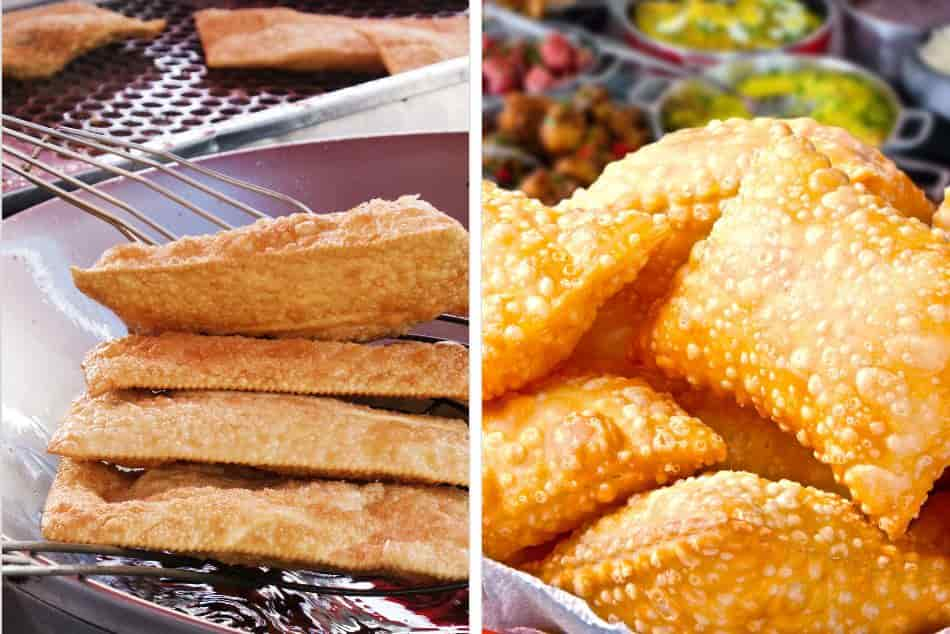
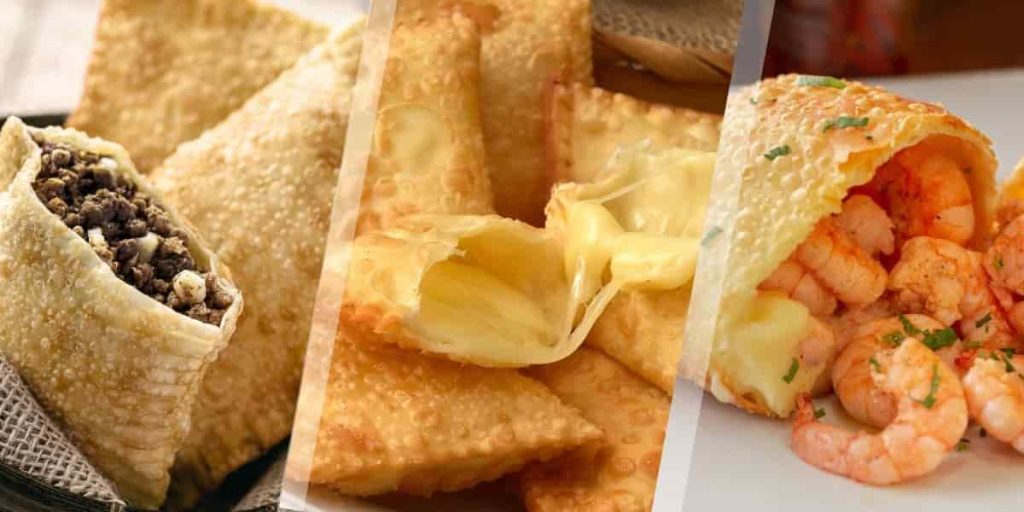
18. Acarajé (Brazilian Falafel)
Another famous dish in Brazil you must try before leaving is acarajé, the Brazilian falafel. It is very popular in the North-East, but you can find it pretty much everywhere.
Acarajé is a deep-fried patty filled with black-eyed peas, palm oil, onions, and topped with vatapá, then covered in a spicy sauce.
It is originally a Nigerian dish sold by ex-slaves on the streets, but the local ingredients used over the years make it just as Brazilian as it is West African!
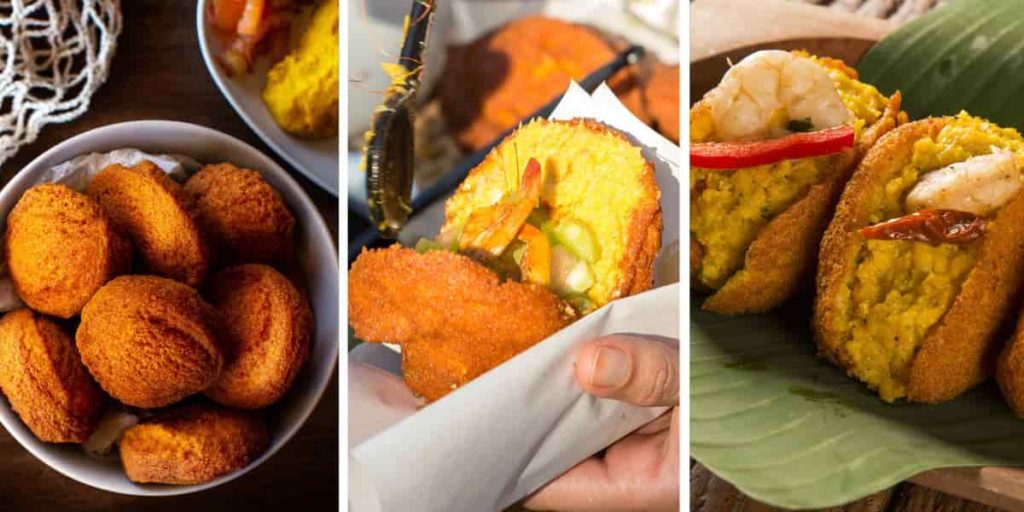
19. Pamonha (Corn Paste)
If you’re a big fan of corn, then you’ll love pamonha. It’s similar to the Mexican tamale and comes from a dough made entirely of grated and juiced corn.
Pamonha comes from the Old Tupi (indigenous Brazilian tribe language) and translates to “Sticky” in English. It comes in both a sweet and savory variation. It is popularly eaten during Fiesta Junina or June party. Some people even add fillings to their pamonha to give it their own touch.
Pamonha is best enjoyed with coffee, and also goes well with an ice-cold beer. Be sure to try both versions before you leave Brazil!
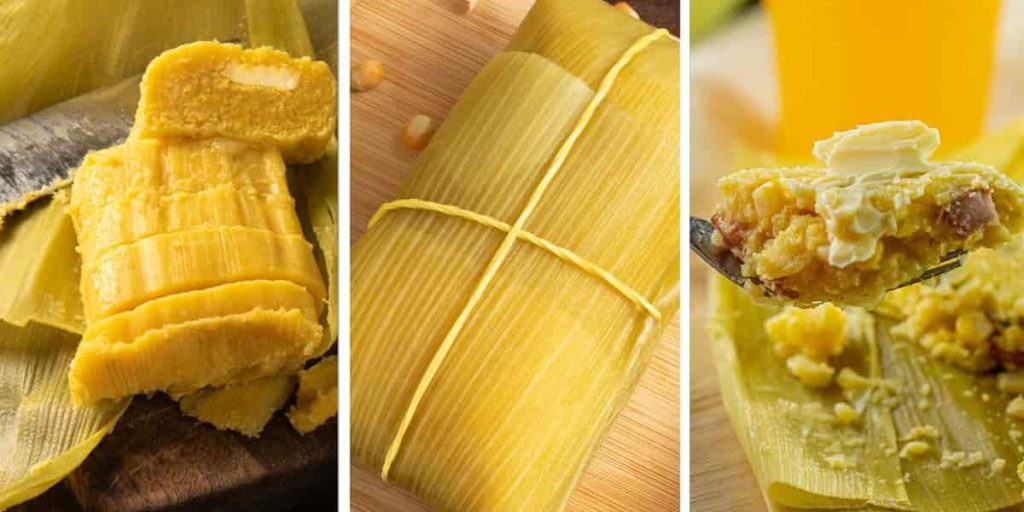
Popular Drinks in Brazil
20. Cachaça (Liquor from Sugarcane)
Cachaça (liquor) comes from sugarcane, but unlike rum, it’s made of fermented cane juice instead of molasses. This drink dates back to the 1500s and is one of the most famous drinks in Brazil.
Cachaça was originally popular among slaves and laborers, but soon became a drink enjoyed among all classes. It is the native liquor of Brazil and is the main ingredient in the national drink of Brazil, caipirinha.
Before trying caipirinha, it’s recommended to try cachaça first so that you can appreciate the sweet, yet spicy beverage. Note that true cachaça is only produced in Brazil, and you can only find the best quality and most authentic cachaça here!
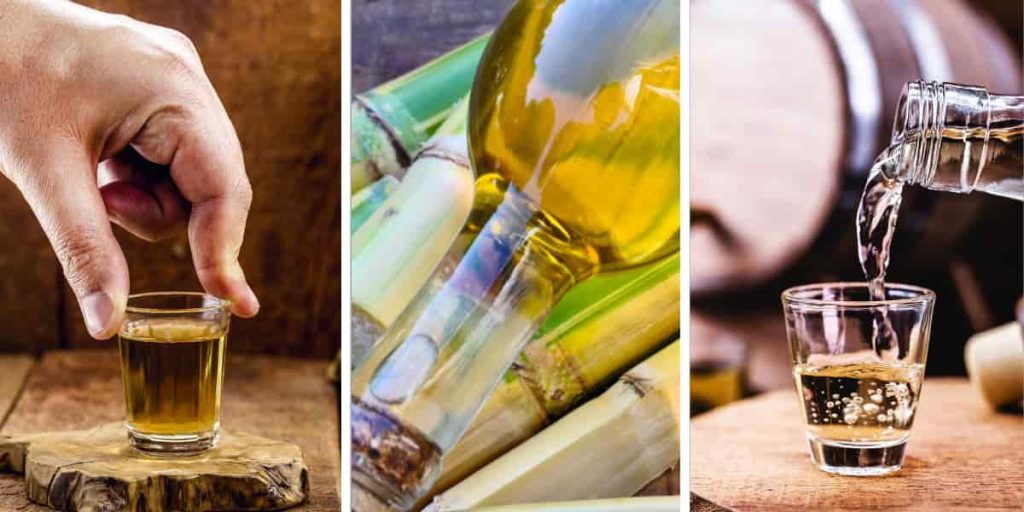
21. Caipirinha
The name caipirinha comes from the word caipira, which refers to Brazilians from rural south-central Brazil.
Caipirinha is the national cocktail of Brazil. It is traditionally made using cachaça, brown sugar and lime, but many locals have their own unique twist. Brazilians usually make caipirinha in large jugs and serve it to others in a social or communal setting.
The drink was also traditionally used as a treatment for the Spanish flu with added honey; it is still used by Brazilians today to beat the common cold.
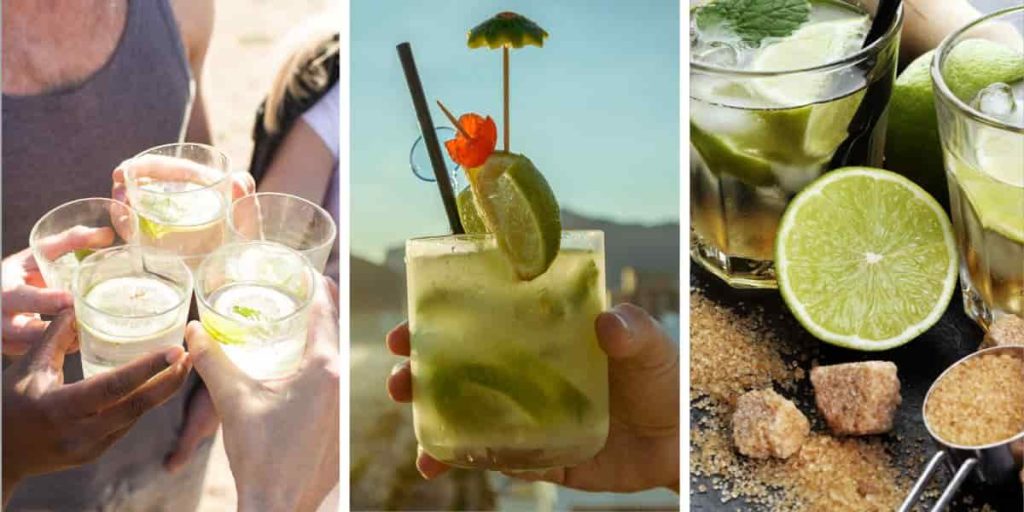
22. Quentão (Brazilian Mulled Wine)
The term quentão translates to “Very hot” in English, and that’s exactly how it is served in Brazil. This drink is usually served at the beginning of winter, marked by the Festa Junina, which is a festival celebrating the changing of seasons.
Quentão is made using heated cachaça, sugar, lemon, ginger, caramelized red apples, cloves and cinnamon. In the southernmost parts of Brazil, cachaça is often substituted with red wine.
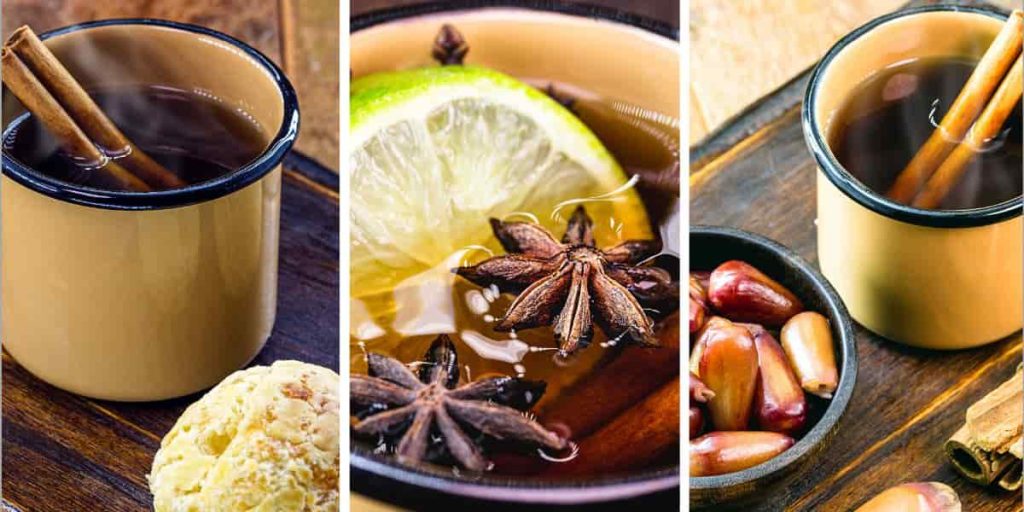
Popular Brazilian Soups/Stews to Taste
23. Bobó de camarão (Shrimp Bobo)
Bobó de camarão, or shrimp bobo, is similar to a West African dish called ipetê. It is a puree of cassava meal, shrimp, and coconut milk. It also contains palm oil, garlic, ginger, onions, and herbs and spices specific to whichever region it is made in.
Bobó de camarão is similar to chowder. It may be enjoyed by itself or with a steaming bowl of white rice. It’s especially popular in north-eastern Brazil. Some variations include a substitution of palm oil or dendê for olive oil.
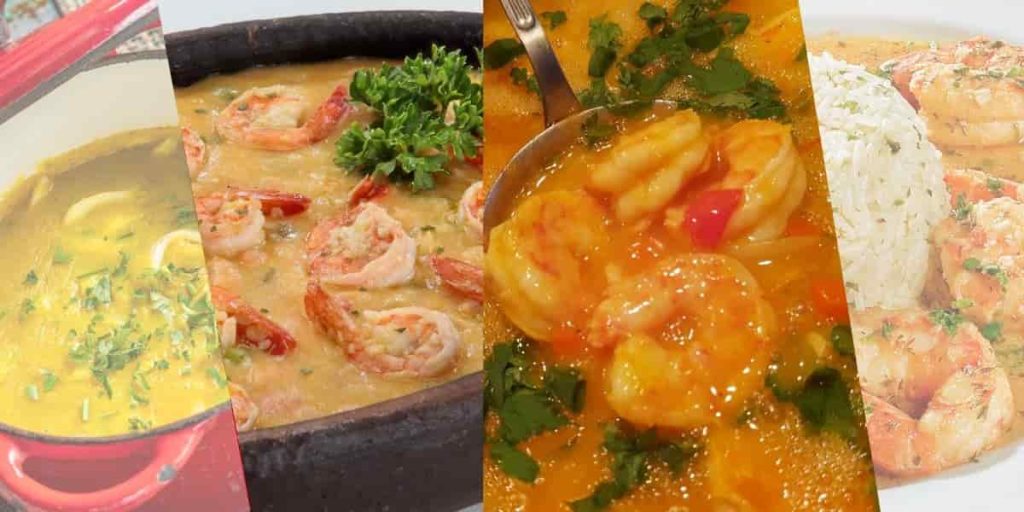
24. Moqueca (Seafood Stew)
Moqueca (stew) can be traced back to roughly 300 years ago following the introduction of palm oil by Africans and coconuts by the Portuguese. However, many claim it was from the Amerindians.
Today, this seafood stew is made with palm oil or olive oil, coconut milk, shrimp, lobster and/or fish. It also includes fresh vegetables and herbs, including tomatoes, onions, coriander and cilantro. Moqueca may be eaten on its own as a soup, but many prefer this heavy stew over white rice.
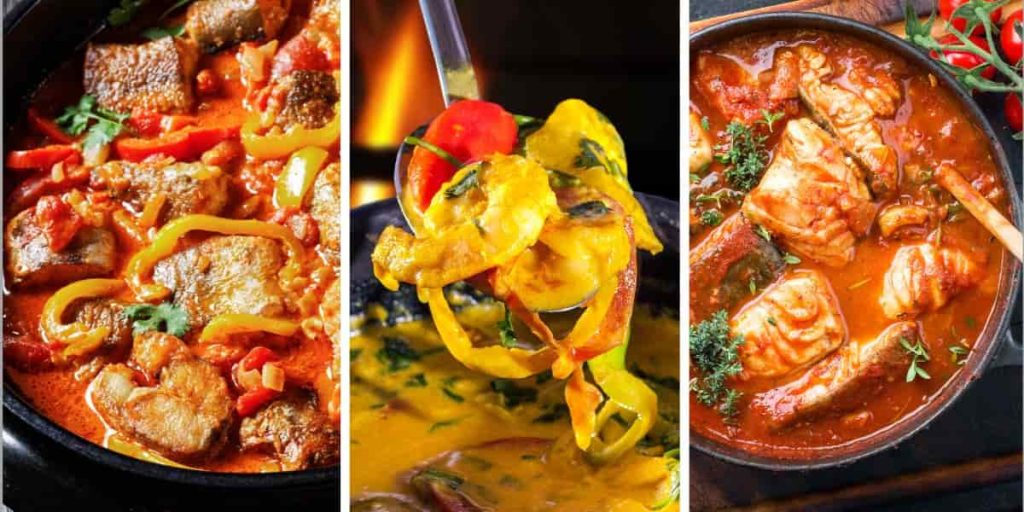
25. Quibebé (Pumpkin Puree)
Quibebé is another soup that originated in the North-East of Brazil. It is perfect for vegetarians since it does not typically contain meat. It is made from winter squash, onions and peppers. It has a thicker consistency than most soups and has a spicy flavor, similar to curry.
It functions well as an appetizer but can be enjoyed on its own or with a side if you prefer.
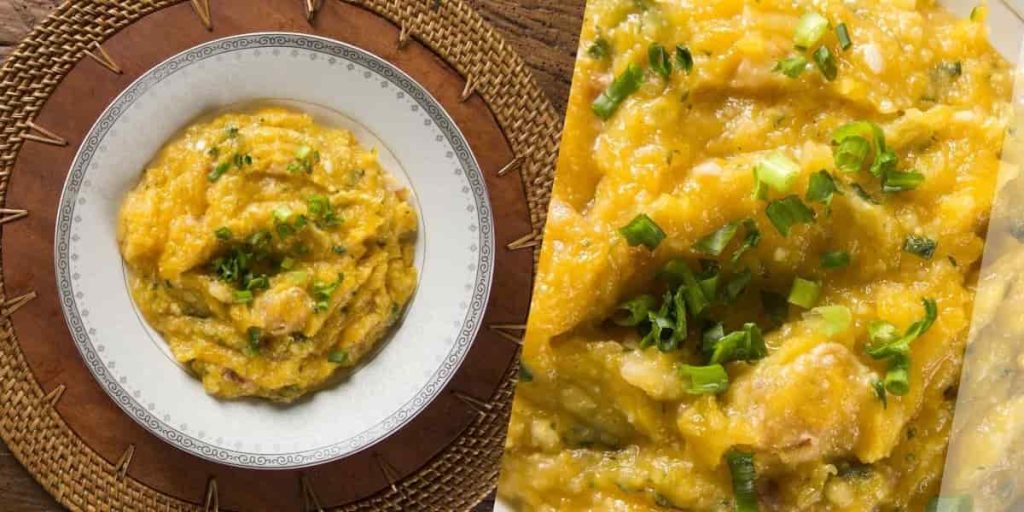
Conclusion
Every famous dish in Brazil you chow down on will remind you of the rich history of this South American country. You won’t be able to experience these flavors anywhere else in the world, making Brazil one of the best countries to travel to for food-lovers!

Ashton3721
Sunday 7th of December 2025
https://shorturl.fm/gTnRb
Logan4693
Saturday 6th of December 2025
https://shorturl.fm/RpBEG
Debbie4810
Wednesday 3rd of December 2025
https://shorturl.fm/rdRWI
binance Registrierung
Thursday 27th of November 2025
Your point of view caught my eye and was very interesting. Thanks. I have a question for you. https://www.binance.info/register?ref=IHJUI7TF
ustvarite racun na binance
Tuesday 25th of November 2025
Your point of view caught my eye and was very interesting. Thanks. I have a question for you. https://accounts.binance.info/register-person?ref=IXBIAFVY